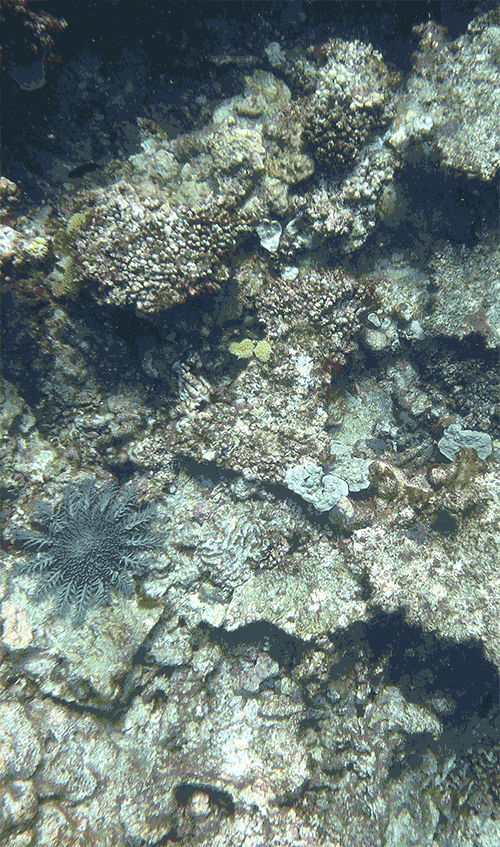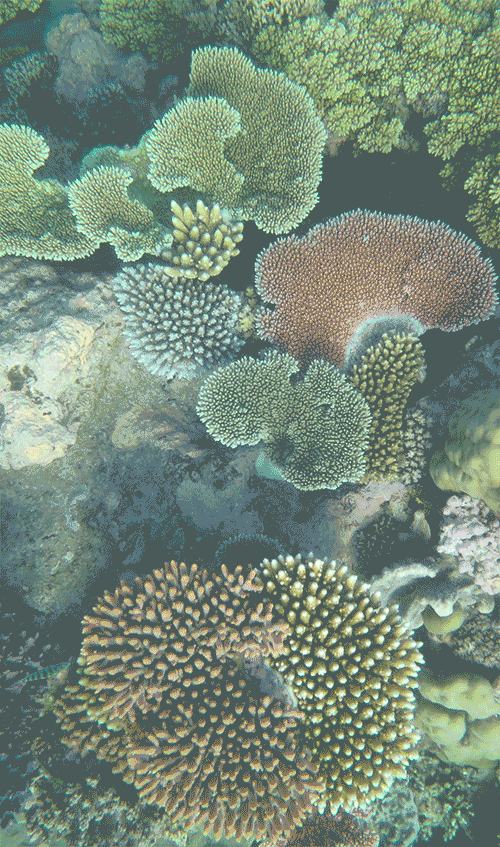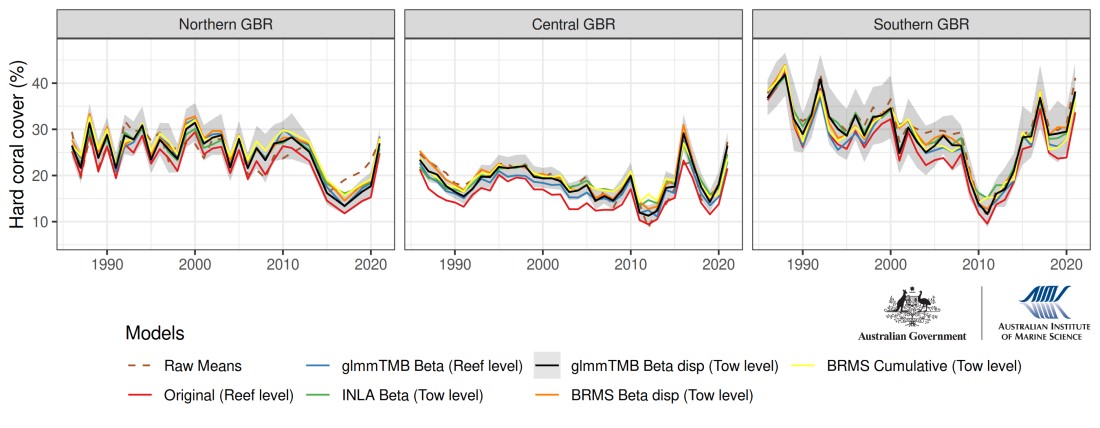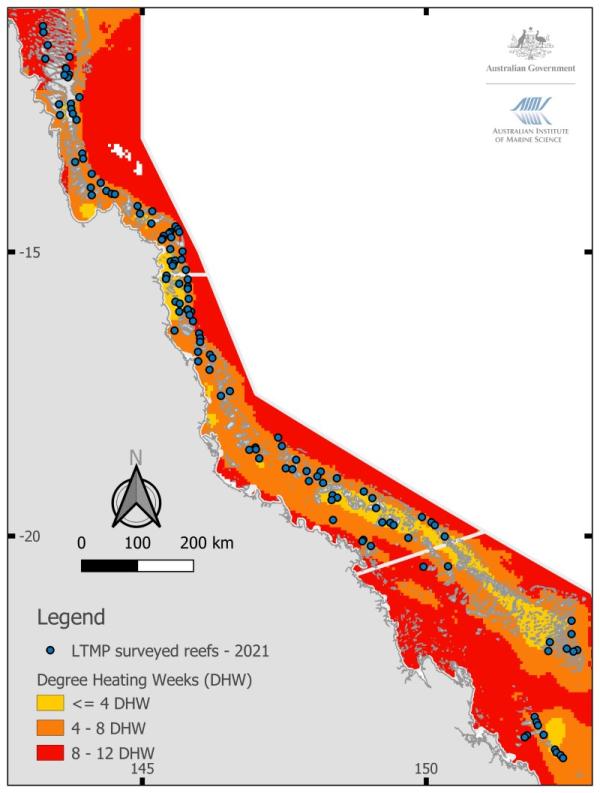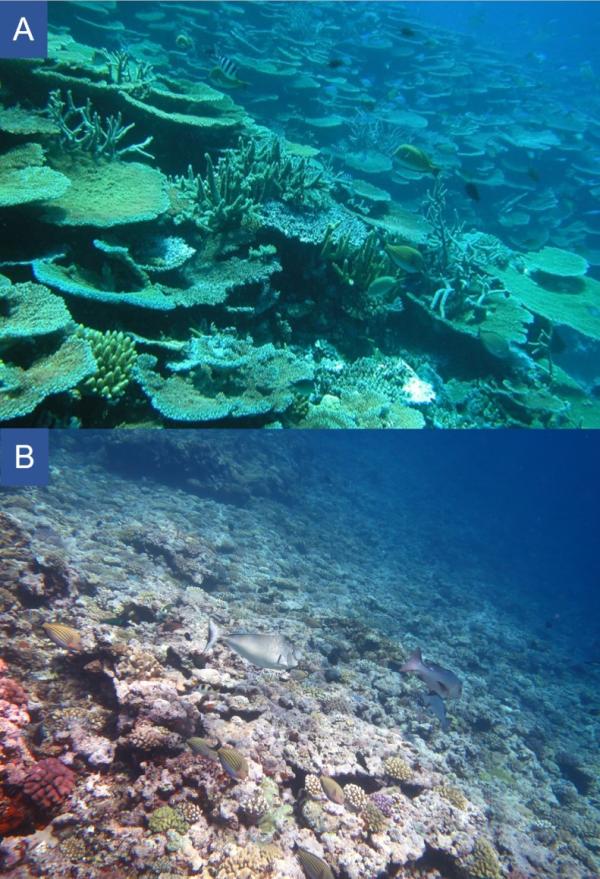Key results
- This report summarises the condition of coral reefs of the Great Barrier Reef (GBR) from the Long-Term Monitoring Program (LTMP) surveys of 127 reefs conducted between August 2020 and April 2021 (reported as ‘2021’).
- Over the 35 years of monitoring by AIMS, the reefs of the GBR have shown an ability to recover after disturbances.
- In 2021, widespread recovery was underway, largely due to increases in fast growing Acropora corals.
- Survey reefs experienced low levels of acute stressors over the past 12 months with no prolonged high temperatures or major cyclones. Numbers of outbreaks of crown-of-thorns starfish on survey reefs have generally decreased; however, there remain ongoing outbreaks on some reefs in the Southern GBR.
- Overall, 59 out of 127 reefs had moderate (>10% - 30%) hard coral cover and 36 reefs had high (>30% - 50%) hard coral cover.
- On the Northern GBR, region-wide hard coral cover was moderate and had continued to increase to 27% from the most recent low point in 2017.
- On the Central GBR region-wide hard coral cover was moderate and had increased to 26% in 2021.
- Region-wide hard coral cover on reefs in the Southern GBR was high and had increased to 39% in 2021.
- In 2020, most of the surveyed reefs experienced heat stress accumulation that produced widespread coral bleaching but was below thresholds where widespread mortality is expected to occur. Consistent with this, surveys in 2021 recorded low coral mortality from the 2020 bleaching event.
- In periods free from acute disturbances, most GBR coral reefs demonstrate resilience through the ability to begin recovery. However, the reefs of the GBR continue to be exposed to cumulative stressors, and the prognosis for the future disturbance regime is one of increased and longer lasting marine heatwaves and a greater proportion of severe tropical cyclones.
Background
With reef surveys extending over 35 years, the AIMS Long-Term Monitoring Program (LTMP) provides an invaluable record of change by repeatedly surveying coral reef communities over a large area of the Great Barrier Reef (GBR).
This annual update of the state and trends in hard coral cover across the entire GBR is based on manta tow surveys of coral reefs, mainly on the mid- and outer shelf (Figure 1).
A total of 127 reefs were surveyed from August 2020 to April 2021 (reported as ‘2021’). Detailed reports on the state and trends of reefs by latitudinal sectors and of individual reefs, including their disturbance history, and are available shortly after the completion of each survey trip. Data summaries are available for download.
The dynamic nature of GBR coral reefs and the considerable variation among regions in the rates of decline and recovery of hard coral cover in response to disturbances are clear in the long-term record. Understanding the dynamics of the disturbance regime provides a critical context for the interpretation of the long-term monitoring data.
For annual updates, the GBR Marine Park is divided into three regions (Figure 1), with each showing different trajectories of change in hard coral cover over time, mostly in response to the cumulative impacts of the main disturbances affecting the surveyed reefs, e.g., severe tropical cyclones, outbreaks of crown-of-thorns starfish and coral bleaching.
The LTMP provides the longest running, most spatially extensive dataset collected by standard methods on the GBR (see Box 1).
Due to logistical and cost constraints, the numbers of reefs surveyed each year are small compared to the number of reefs found on the GBR (~100 vs 3000). However, the LTMP survey reefs provide a representative sample across the length and breadth of the GBR that captures several geographical and ecological gradients (e.g., latitude, position across the continental shelf) and encapsulates many of the bioregions and all the management zones defined in the 2004 rezoning of the Marine Park.
AIMS is committed to continual improvement in the analyses of LTMP data, and recent statistical advances have permitted a refinement of analytical approaches used to analyse the type of ecological time series data used in this report.
This year we have examined the effectiveness of several approaches and present an ensemble of various statistical models with a justification for the choice of the model selected in this report (see Box 2).
RESULTS - Condition Summary to April 2021
Northern Great Barrier Reef
(Surveyed October to December 2020)
There was substantial variation in the condition of individual reefs in the Northern GBR (Figures 1 and 2, Image 1).
Seven of 54 reefs surveyed had low coral cover (>0% - 10%), 29 reefs had moderate coral cover (>10% - 30%), 14 reefs had high (>30% - 50%) and four had very high coral cover (>50% - 75%) (Figures 1 and 2).
Recovery was underway on the majority of Northern GBR reefs following a period of cumulative disturbances stretching from 2014 to 2020.
Of the 32 reefs previously surveyed in the last two years, only six had decreased in hard coral cover (Figure 1), indicating there was minimal mortality from the 2020 mass coral bleaching event at these survey reefs.
The impacts of this event are discussed in more detail further below.
Region-wide hard coral cover continued to increase from the lowest levels recorded by the LTMP in 2017 to 27% in 2021 (Figure 3).
Surveys in 2021 found little evidence of crown-of-thorns starfish activity in the region, most reefs were classified as No COTS and No Outbreak and only one reef classified as Incipient Outbreak (Figure 1).
In 2021, surveys were conducted prior to peak summer temperatures.
During surveys, 15 of 54 Northern GBR reefs had low-level bleaching (<10% of corals bleached), with no bleaching recorded on the remainder. This indicates there was some accumulation of thermal stress in 2021.
Central Great Barrier Reef
(Surveyed January to April 2021)
Since regular surveys by AIMS began in 1985, hard coral cover on reefs in the Central GBR has generally been lower than in the Northern and Southern GBR.
Region-wide hard coral cover in the Central GBR decreased to the lowest level in LTMP records in 2012, following the impact of Severe Tropical Cyclone Yasi in 2011 (Figure 4). Hard coral cover then recovered rapidly to the highest average regional cover in the LTMP database record in 2016 (29%).
From 2016 to 2019, hard coral cover decreased continuously to 14% (Figure 4), largely due to repeated mass coral bleaching in 2016 and 2017 and outbreaks of crown‐of‐thorns starfish. In 2021, hard coral cover had increased again to 26% (Figure 4).
The status of the reefs in the Central GBR was variable in 2021; 32 of the 53 reefs surveyed had low or moderate hard coral cover (<30%) while 21 reefs had coral cover higher than 30% (Figures 1 and 2, Image 2). None of the surveyed reefs had hard coral cover higher than 75% (Figure 2).
A total of 30 of the 53 Central GBR reefs surveyed in 2021 had been previously surveyed within the last two years. Hard coral cover had declined on only two reefs while increasing on most of them (28 reefs; Figure 1).
Many reefs offshore from Cairns, Innisfail, and Townsville have had outbreaks of crown-of-thorns starfish in recent years. However, there were no Incipient or Active Outbreaks of crown-of-thorns starfish recorded on Central GBR reefs in 2021 (Figure 1).
The Great Barrier Reef Marine Park Authority’s Crown-of-thorns Starfish Control Program has been actively removing substantial numbers of starfish in this area, which would have contributed to the low numbers of crown-of-thorns starfish recorded during these surveys.
Coral bleaching was widespread in the Central GBR during the last surveys in 2020, although the severity varied among reefs. The impacts of this event are discussed in more detail further below. Central GBR reefs surveyed in 2021 had low-level bleaching (<10% of corals bleached), indicating there was some accumulation of thermal stress. No bleaching levels higher than this were recorded.
Southern Great Barrier Reef
(Surveyed August 2020)
The Southern GBR has generally had higher coral cover than the Northern or Central GBR, but it has also been the most dynamic over the 35-year survey history. Large declines in hard coral cover followed Severe Tropical Cyclone Hamish in 2009, which reduced coral cover to the lowest levels recorded by the LTMP in 2011 (Figure 5). A large increase in hard coral cover occurred from 2011 to 2016, reaching 37% in 2017. However, outbreaks of crown-of-thorns starfish began in 2018 and regional coral cover decreased to 29% in 2019. In 2021 coral cover has increased again to 39% (Figure 5).
The state of individual Southern GBR reefs was variable (Image 3) however, there was a greater proportion of reefs with high coral cover than low or moderate coral cover, a contrast to the Northern and Central GBR where the majority of reefs had coral cover in the two lowest categories (Figures 1 and 2). Of the 20 reefs surveyed in 2021, 19 reefs have been surveyed in the last two years. Hard coral cover decreased on four of these, whereas 15 reefs increased in hard coral cover (Figure 1).
In 2016 and 2017, reefs in the Southern GBR were not exposed to the extreme sea surface temperatures that led to the mass coral bleaching on the Central and Northern GBR. However, in the austral summer of 2020, waters of the Southern GBR warmed substantially. Aerial surveys by the ARC Centre of Excellence in Coral Reef Studies revealed widespread severe bleaching across much of the Southern GBR. However, only two reefs accumulated degree-heating weeks[1] (DHW) values in 2020 that were above the level at which mortality would have been expected. The impacts of this event are discussed in more detail further below.
In 2021, there was widespread low-level bleaching (<10% of colonies)of sensitive species during surveys, however no instances of more severe bleaching were observed. The Southern GBR was the epicentre of crown-of-thorns starfish outbreaks in 2021, with three of the 20 reefs classified as having Active Outbreaks and one reef with an Incipient Outbreak (Figure 1). Low numbers of crown-of-thorns starfish were recorded on three reefs classified as Recovering or No Outbreak.
The Great Barrier Reef Marine Park Authority’s Crown-of-thorns Starfish Control Program has been actively removing substantial numbers of starfish in this area.
1Degree Heating Weeks (DHW) shows the accumulated heat stress over the previous three months by adding up the time when temperature exceeds the bleaching threshold. Significant coral bleaching is predicted above 4 DHW and coral mortality is expected above 8 DHW. Further information available from NOAA.
The impact of the 2020 mass coral bleaching event
In the austral summer of 2020, the Great Barrier Reef was subjected to accumulated heat stress to the level at which mass coral bleaching occurred across much of the GBR. This included the Southern GBR which had escaped bleaching in the 2016 and 2017 events. The third such event in five years is a sign that the Great Barrier Reef is already experiencing the consequences of climate change.
Aerial surveys undertaken by the Centre of Excellence in Coral Reef Studies in 2020 revealed extensive mass coral bleaching on the Southern GBR for the first time, as well as widespread bleaching in the Central and Northern GBR.
Of the reefs surveyed by the LTMP using manta tow in 2021, 81 were surveyed within the last two years allowing an appraisal of the impacts of the 2020 mass coral bleaching. Only twelve reefs had decreased in hard coral cover.
Decreases in coral cover on most of these twelve reefs were most likely associated with heat stress during the 2020 mass bleaching event, as there were few other acute pressures. However, three of these reefs also had crown-of-thorns starfish at densities expected to cause coral mortality and their coral cover declines cannot be attributed solely to coral bleaching.
These results indicate minor impacts on coral cover on the LTMP survey reefs from the 2020 mass coral bleaching event. However, it is important to place these results into the context of the accumulated heat stress experienced by survey reefs during the 2020 event, recorded as degree-heating weeks (DHW).
Accumulated heat stress was variable across the GBR in 2020 (Figure 6). DHW information was available for 126 out of 127 reefs surveyed in 2021. Of these, 101 reefs experienced heat stress during 2020 that was greater than the threshold at which widespread mass coral bleaching is expected (4 DHW; Figure 6). This agrees with the observations from aerial surveys of widespread bleaching across the Great Barrier Reef.
However, only 15 survey reefs experienced heat stress above the levels at which mortality from coral bleaching is expected (8 DHW; Figure 6). This agrees well with the LTMP observations that most reefs surveyed by the LTMP in 2021 appear to have undergone minimal coral mortality following the 2020 bleaching event.
Heat stress accumulation between 4 and 8 DHW can cause some mortality but is more likely to produce sub-lethal effects like reduced growth, reproductive output and larval settlement. These sub-lethal effects can have long-lasting impacts on the recovery dynamics of coral reefs; however, the full extent of these impacts is poorly understood and will only become evident in the future.
The LTMP surveys a representative but small proportion of GBR reefs and there are reefs not surveyed that experienced high levels of accumulated heat stress above thresholds at which we would expect to see coral mortality.
This year has seen recovery underway on LTMP survey reefs across much of the GBR. However, the metric hard coral cover, while being a simple and robust measure of reef condition, reveals nothing about the diversity or composition of coral assemblages.
To assess this, the LTMP also quantifies the percent cover of different coral types using digital imagery along permanently marked transects during fixed site surveys, at a smaller subset of reefs across the length and breadth of the GBR.
The majority of recovery was driven by increases in the fast-growing Acropora corals, which have proliferated across many GBR reefs. Once established, these corals enter an exponential growth phase which rapidly increases measures of percent hard coral cover, as documented in this year’s results. However, the fast growth comes at a cost, the skeleton is less dense than other slower growing corals, making them particularly susceptible to wave damage, like that generated by strong winds and tropical cyclones.
They are also highly susceptible to coral bleaching and are the preferred prey for crown-of-thorns starfish. This means that large increases in hard coral cover can quickly be negated by disturbances on reefs where Acropora predominate.
Preliminary analyses have also revealed a shift in the community composition of coral assemblages on some outer shelf reefs in the Northern and Central GBR, where the impacts of the 2016 and 2017 bleaching were greatest.
While there have been increases in hard coral cover in these areas, there has been a shift to coral assemblages dominated by Pocillopora corals (Image 4) rather than the typically dominant Acropora corals. This shift to Pocillopora-dominated reefs likely results from different mechanisms on different reefs and may include:
- Adult Pocillopora have survived bleaching where other corals have died, and,
- Surviving Pocillopora can produce more offspring after bleaching as they are more numerous and spawn more frequently than other corals like Acropora
The replacement of Acropora corals by Pocillopora has important ramifications. For example, slower growth of Pocillopora will likely result in decreased speed of recovery. Additionally, impacts to other animals, like fishes, which are dependent on Acropora corals for food and shelter, may become apparent due to the reduced habitat complexity of a Pocillopora-dominated reef.
AIMS will continue to monitor these reefs to determine whether Pocillopora continues to dominate, how that will affect other parts of the reef ecosystem, as well as conduct more detailed analyses of the longer-term effects of bleaching and other disturbances on the trajectory of coral reef status.
Assessing the long-term health of the Great Barrier Reef
Determining the status of the GBR requires robust long-term datasets collected using standard methods. Long-term data are particularly important to avoid the “shifting baseline” syndrome, as the results each year are always considered in the context of the long-term trends.
The last couple of years have revealed that recovery is underway across much of the GBR, a promising sign illustrating that the GBR still has the capacity and necessary ecological functions to recover from disturbances.
The Central and Southern GBR had periods of recovery within the last decade which have been curtailed by disturbances, arresting recovery, and causing further coral declines. Sustained recovery of the GBR back to historical high coral cover requires the next few years to be disturbance free to allow corals to continue to grow and increase their populations.
While there have been hard coral cover increases across all three regions over recent years, the Northern and Southern GBR are still below the highest recorded coral cover in the 1980s, and preliminary analyses have documented shifts in the dominant corals on some reefs.
2021 has been a low disturbance year, while the period from 2014 to 2020 was an intense period of widespread disturbances. There were numerous severe tropical cyclones and three mass coral bleaching events in five years. The fourth wave of crown-of-thorns starfish outbreaks began around 2010 between Lizard Island and Cairns, and by 2020 had progressed south to reefs offshore from Townsville.
The prognosis for the future disturbance regime under climate change is one of increasingly frequent and longer lasting marine heatwaves and a greater proportion of severe tropical cyclones. Mitigation of these climatic threats requires immediate global action on climate change.
Crown-of-thorns starfish as coral predators are a major cyclic disturbance on the GBR and when left unchecked, outbreaks can decimate coral populations. However, it is one of the few threats to the GBR that can be directly managed locally.
The Crown-of-thorns Control Program has been active on the GBR during the current outbreak and seeks to reduce starfish numbers at key reefs to reduce the amount of coral lost and to diminish the brood stock which propagates the outbreak ‘wave’ southward through most of the GBR.
In 2021, the number of Active Outbreaks has decreased from previous years, although outbreaks were still recorded in the Swain sector of the Southern GBR. The LTMP aims to assist analyses of the effectiveness of the Crown-of-thorns Control Program in the next few years.
The predicted consequences of climate change, which include more frequent and intense mass coral bleaching events, are now a contemporary reality. Simultaneously, chronic stressors such as high turbidity, increasing ocean temperatures and changing ocean chemistry can all negatively affect recovery rates, while more frequent acute disturbances mean that the intervals for recovery are becoming shorter.
Measuring and understanding the process of, and limitations to, coral reef recovery will be a continued focus of AIMS’ research and monitoring over the next years.




